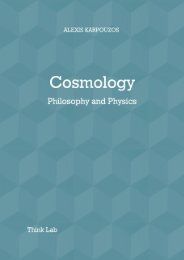THE END OF CERTAINTY - ALEXIS KARPOUZOS
Chaos, Complexity And Self-Organized Systems
Chaos, Complexity And Self-Organized Systems
You also want an ePaper? Increase the reach of your titles
YUMPU automatically turns print PDFs into web optimized ePapers that Google loves.
time) and secondly, the various levels of description can lead to the same future<br />
state.<br />
The Role Of The Dispersing Structures And Of The Bifurcations.<br />
According to the second law of thermodynamics, in an isolated system (i.e. which<br />
does not exchange matter and energy with its environment), the total entropy<br />
increases progressively, while the free energy decreases until the system reaches<br />
the equilibrium state, when its entropy acquires its maximum value. In<br />
thermodynamic equilibrium state, the system is homogeneous and idle. If we also<br />
suppose, as Clausius did, that the whole universe is an isolated system of gigantic<br />
dimensions, then, according to the second law, the progressive degradation of the<br />
energy, i.e. the maximization of entropy inevitably leads to the "heat death" of the<br />
universe.<br />
In classical thermodynamics the arrow of time, i.e. the decay, the disorder and the<br />
death, is introduced. Classical thermodynamics referred to isolated and closed-linear<br />
systems.<br />
However, how can we explain the “weird” behavior of the open systems? These<br />
systems are located far from the equilibrium state and continuously exchange matter<br />
and energy with their environment. They do not tend to a state of minimum free<br />
energy and maximum entropy, but, on the contrary, they use some energy inputs and<br />
fluctuations not only in order to maintain their structural stability but also in order to<br />
evolve towards new dynamical states.<br />
The open thermodynamic systems are the rules, not the exception. Those systems<br />
contain not only the living organisms and the human societies, but also the greatest<br />
part of the “simpler” physicochemical systems. Prigogine proved that on conditions<br />
away from thermodynamic equilibrium state, the matter acquires new unexpected<br />
properties, organizes itself and produces complex structures from random<br />
fluctuations.<br />
He will name these structures dissipative structures. Basically, we are talking about<br />
systems which consume energy. The dissipative structures are states which reflect<br />
their interaction with the environment, with which they interchange energy, sustained<br />
through an endless dynamic flow.<br />
7









